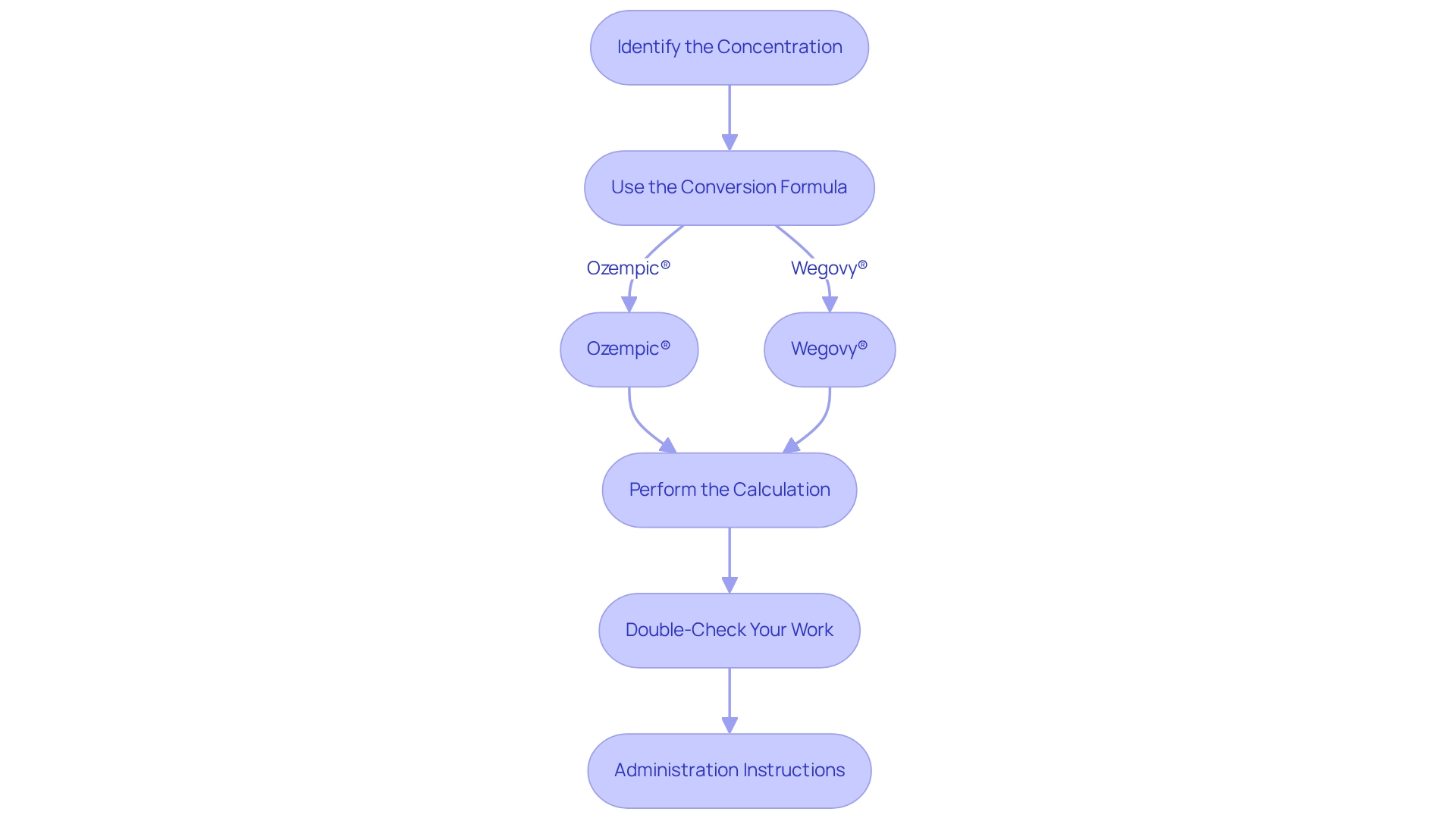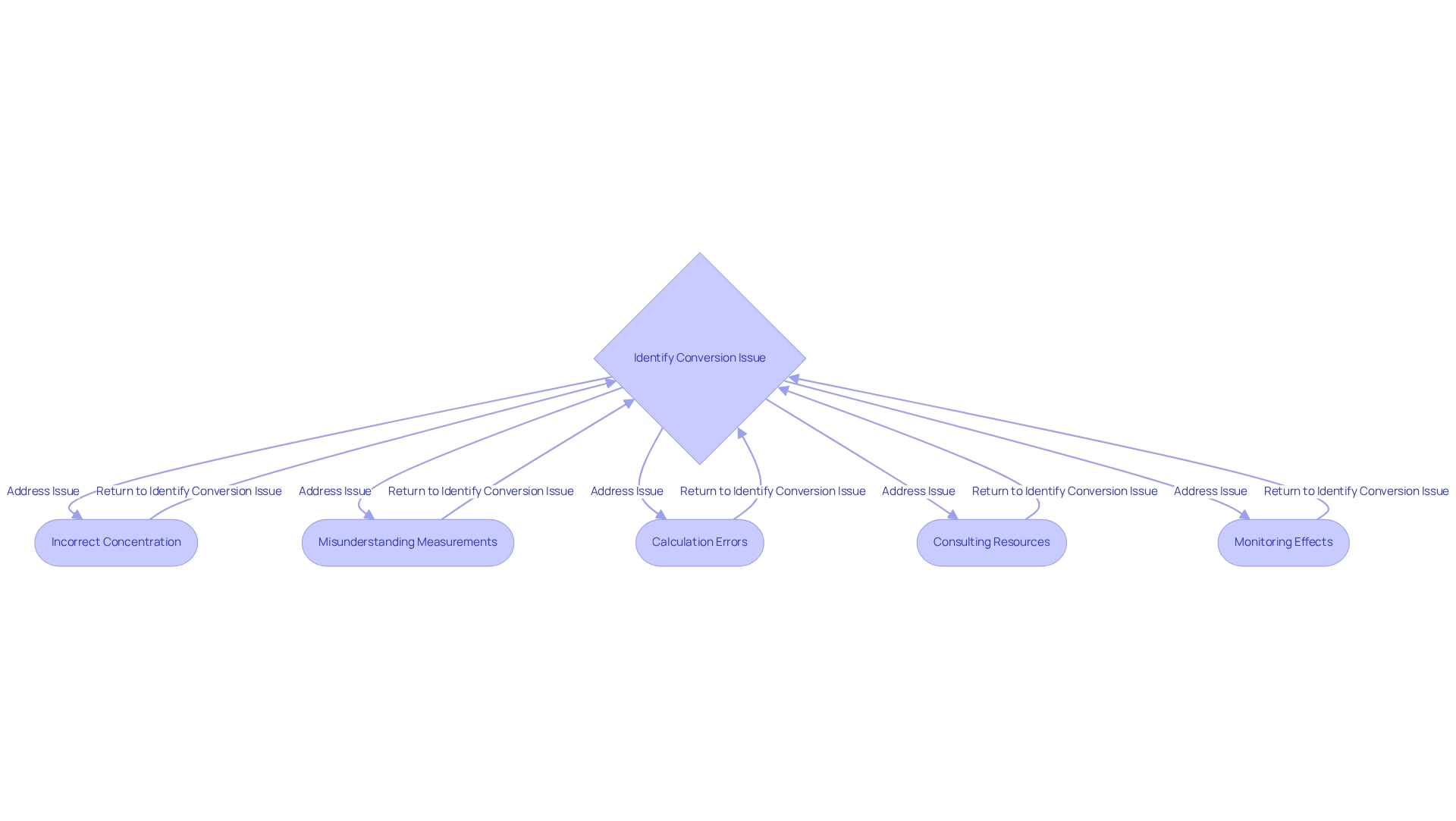Overview
This article offers a compassionate, step-by-step guide to help you convert Semaglutide units to milligrams. We understand that navigating medication can feel overwhelming, and it’s crucial to grasp the medication’s concentration and use the right conversion formula. By detailing specific calculations for various formulations like Ozempic® and Wegovy®, we aim to empower you with the knowledge you need. Additionally, we provide common troubleshooting tips to help you avoid dosing errors, ensuring that you can achieve effective treatment outcomes. Remember, we’re here for you on this journey.
Introduction
In the realm of diabetes management and weight loss, semaglutide has emerged as a groundbreaking solution, capturing the attention of healthcare professionals and patients alike. This innovative treatment, a glucagon-like peptide-1 (GLP-1) receptor agonist, offers multifaceted benefits that extend beyond mere weight reduction. It can significantly improve blood sugar control and even support cardiovascular health. However, we understand that the journey to harnessing its full potential can feel overwhelming. That’s why it’s essential to have a comprehensive understanding of dosing and administration.
With various formulations available, knowing how to accurately convert units to milligrams is crucial for achieving optimal results. This article is here to guide you through the essentials of semaglutide. We provide a step-by-step approach to effective conversion and troubleshooting common issues. Together, we can navigate your treatment with confidence and clarity, ensuring you feel supported every step of the way.
Understand Semaglutide: Basics and Benefits
Semaglutide, a glucagon-like peptide-1 (GLP-1) receptor agonist, is primarily used to help manage type 2 diabetes and support weight loss. By enhancing insulin secretion, curbing appetite, and slowing gastric emptying, it plays a crucial role in reducing body mass and improving glycemic control. Many individuals have found substantial benefits from this medication, including significant weight loss, better blood sugar regulation, and even potential cardiovascular improvements. If you’re considering this option or need help with dosage management, understanding these aspects is vital.
Available in formulations like Ozempic® and Wegovy®, Semaglutide is tailored for specific dosing regimens. It’s important to accurately convert dosage from semaglutide units to mg based on the formulation’s concentration. Recent studies highlight its efficacy, showing that many patients experience remarkable fat reduction—up to 20%—along with improvements in lipid levels, as revealed by clinical trial results. However, about 16% of patients may require adjustments to their medication regimen, underscoring the importance of personalized care in treatment strategies. This statistic emphasizes the necessity for healthcare providers to closely monitor and customize treatment plans to ensure the best outcomes for each individual.
The findings from the SELECT study are poised to influence future obesity treatment guidelines, reinforcing the vital role of GLP-1 receptor agonists in comprehensive management strategies. As healthcare professionals increasingly recognize the diverse advantages of this medication, its application in both weight reduction and diabetes control is gaining momentum. This positions Semaglutide as a crucial option for those seeking effective health solutions. At Minimal, we are committed to providing personalized weight loss strategies, ensuring that patients receive tailored support that includes prescription assistance, fitness and nutrition plans, and regular progress evaluations.
While Semaglutide offers many benefits, it’s essential to be aware of potential side effects, such as nausea, vomiting, diarrhea, and stomach discomfort. Long-term use may lead to decreased vitamin B12 levels, and in rare cases, serious conditions like lactic acidosis can occur if not used properly. Semaglutide is administered through a subcutaneous injection, typically once a week, and can be injected into the thigh, abdomen, or upper arm. Mastering the proper injection technique is crucial for effective treatment. Remember, we’re here for you, and together, we can achieve your health goals.
Convert Semaglutide Units to mg: Step-by-Step Process
To change the medication’s measurements to milligrams, please follow these supportive steps:
-
Identify the Concentration: Begin by determining the concentration of your semaglutide formulation. Common concentrations include 0.25 mg per dose, 0.5 mg per dose, and the conversion of semaglutide units to mg for 1 mg per dose.
-
Use the Conversion Formula: The general formula for conversion is:
- For Ozempic® (0.5 mg/mL): 1 mg = 20 units. Therefore, to convert units to mg, simply divide the number of units by 20.
- For Wegovy® (2 mg/mL): 1 mg = 10 units. Thus, to convert the quantity of items into semaglutide units to mg, divide by 10.
-
Perform the Calculation: For example, if you have 40 units of Ozempic®, the calculation would be:
- 40 units ÷ 20 = 2 mg.
- If you have 20 units of Wegovy®, the calculation would be:
- 20 units ÷ 10 = 2 mg.
-
Double-Check Your Work: It’s always wise to verify your calculations to ensure accuracy. Mistakes in dosing can lead to ineffective treatment or adverse effects.
-
Administration Instructions: Remember, Wegovy® is administered once a week, ideally at the same time each week. It comes as an injection pen that you will use on your abdomen, thigh, or upper arm. Please adhere to the guidelines meticulously and alternate injection locations to prevent discomfort.
It’s crucial to acknowledge that individuals with a history of pancreatitis have not been examined with this treatment, so caution is recommended. Furthermore, medications like somapacitan, somatrogon, and somatropin might reduce the impact of semaglutide, requiring careful supervision.
At a minimum, numerous clients have successfully managed these transitions, leading to a high success rate where participants have shed up to 20% of their body mass over six months. Dr. Okojie, a board-certified doctor, encourages patients interested in the Semaglutide program for weight loss to call for a consultation to discuss their specific goals and medical history. This highlights the importance of precise dosing in achieving effective weight management outcomes, aligning with our holistic approach to wellness. Together, we can achieve your goals.
Troubleshoot Common Conversion Issues
When converting units of medication to milligrams, it’s understandable that several common issues may arise.
- Incorrect Concentration: It’s crucial to verify the concentration of your medication before proceeding. Using an incorrect concentration can lead to significant dosing errors, which might impact your treatment outcomes. Recent statistics reveal that mislabeling of concentrations occurs in a notable percentage of instances, highlighting the importance of verification.
- Misunderstanding Measurements: Different formulations of semaglutide may use varying measurements, including conversions from semaglutide units to mg. Are you aware of the specific conversion factor applicable to the product you’re using? Understanding these units is essential, as confusion can lead to serious medication errors that could be harmful to your health.
- Calculation Errors: Always double-check your calculations. A simple arithmetic mistake can result in an incorrect dose. Using a calculator or a measurement chart can help reduce mistakes and ensure precision. In fact, many medication errors stem from simple calculation mistakes, underscoring the need for careful verification.
- Consulting Resources: If you have any doubts, please don’t hesitate to consult your healthcare provider. Trustworthy dosage charts available online can serve as quick reference tools to assist you in the conversion process. Healthcare professionals recommend having these resources on hand to avoid potential pitfalls.
- Monitoring Effects: After adjusting your dose, closely monitor your body’s response. If you experience any unexpected side effects, it’s essential to consult your healthcare provider immediately to address any concerns. Ongoing discussions around how to convert semaglutide units to mg emphasize the importance of monitoring and adjusting doses based on individual responses, reinforcing the need for continuous communication with your healthcare team. Remember, we’re here for you, and together, we can navigate these challenges.
Conclusion
Semaglutide has emerged as a transformative option in managing type 2 diabetes and weight loss, offering a wealth of benefits that go beyond just shedding pounds. With its remarkable ability to enhance insulin secretion and reduce appetite, this glucagon-like peptide-1 (GLP-1) receptor agonist has captured attention for its effectiveness in improving blood sugar control and supporting cardiovascular health. It’s essential for patients to understand the nuances of semaglutide, including its various formulations and the critical nature of accurate dosing, to fully harness the potential of their treatment journey.
Converting semaglutide units to milligrams can be a straightforward process when the proper steps are taken. By identifying the concentration of the formulation and applying the correct conversion formula, patients can ensure they are administering the right dosage. Remember, it’s vital to double-check calculations and reach out to healthcare providers whenever uncertainties arise. Even minor errors can have significant consequences, and we’re here to support you in getting it right.
Addressing common conversion issues highlights the importance of vigilance in managing diabetes. From verifying concentrations to understanding unit differences, being proactive can help prevent dosing errors and enhance treatment efficacy. Continuous communication with healthcare professionals and monitoring your individual responses are essential components of a successful semaglutide regimen. Together, we can navigate these challenges.
In summary, semaglutide represents a significant advancement in diabetes management and weight loss strategies. By equipping yourself with knowledge about dosing and administration, you can confidently navigate your treatment journey. The multifaceted benefits of semaglutide, combined with personalized care, pave the way for improved health outcomes, empowering you to take control of your wellness with clarity and support. Remember, we’re here for you every step of the way.
Frequently Asked Questions
What is Semaglutide used for?
Semaglutide is primarily used to manage type 2 diabetes and support weight loss by enhancing insulin secretion, curbing appetite, and slowing gastric emptying.
What benefits have individuals experienced from Semaglutide?
Individuals have reported significant weight loss, better blood sugar regulation, and potential cardiovascular improvements.
What formulations of Semaglutide are available?
Semaglutide is available in formulations like Ozempic® and Wegovy®, which are tailored for specific dosing regimens.
How is the dosage of Semaglutide determined?
It is important to accurately convert dosage from semaglutide units to mg based on the formulation’s concentration.
What results have studies shown regarding the efficacy of Semaglutide?
Recent studies have shown that many patients experience remarkable fat reduction—up to 20%—along with improvements in lipid levels.
Do all patients respond the same way to Semaglutide?
No, about 16% of patients may require adjustments to their medication regimen, highlighting the importance of personalized care.
How might the SELECT study influence future treatment guidelines?
The findings from the SELECT study are expected to influence future obesity treatment guidelines, reinforcing the role of GLP-1 receptor agonists in management strategies.
What are some potential side effects of Semaglutide?
Potential side effects include nausea, vomiting, diarrhea, and stomach discomfort. Long-term use may also lead to decreased vitamin B12 levels, and in rare cases, serious conditions like lactic acidosis.
How is Semaglutide administered?
Semaglutide is administered through a subcutaneous injection, typically once a week, and can be injected into the thigh, abdomen, or upper arm.
Why is mastering the injection technique important?
Mastering the proper injection technique is crucial for effective treatment with Semaglutide.



















